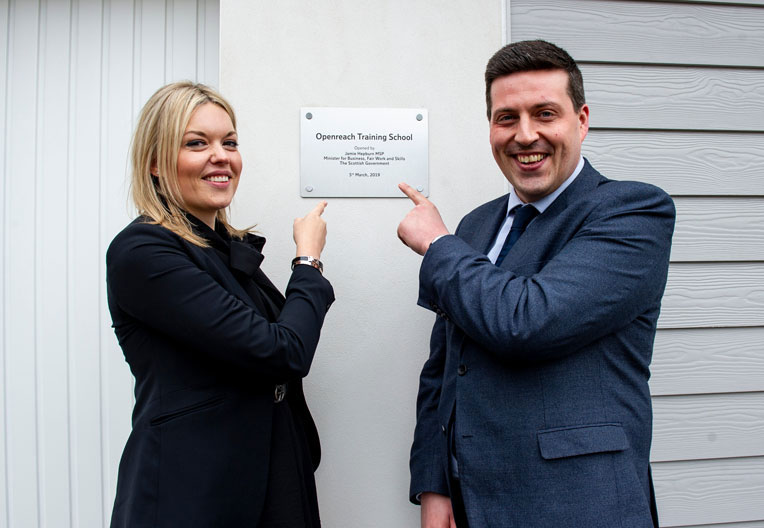- News
- |
- Fibre
The Enabler of Prosperity for Scotland
Society's needs are changing dramatically and so too is the infrastructure on which future generations will depend.
In today’s world of upheaval and uncertainty, there are few constants - but the pace of change in technology is one.
The next generation of broadband – Full Fibre, which runs all the way to your house or place of business – not only brings faster broadband speeds of up to 1 gigabit per second (1Gbps). It’s also more reliable and will meet people’s needs for decades.
“Bundles of copper and fibre cables hidden either in a roadside box or under the ground are fast becoming the arteries through which the lifeblood of society and the economy flows”
What benefits will Full Fibre bring Scotland?
A recent independent Cebr report commissioned by Openreach suggests that connecting everyone in Scotland to Full Fibre broadband could add £4.6 billion to the economy by 2025.
This degree of connectivity will create a more productive and competitive workforce. It enables smarter ways of working, better public services, more social mobility and greater opportunity for the next generation of home-grown businesses.
From connectivity and the environment to enterprise and health and well-being, Full Fibre broadband is an important enabler of change and prosperity. As with other infrastructure projects, the benefits to the country over the long term will far outweigh the cost of installation.
How it will eliminate the disadvantage of location
In a nation where the majority of the population is huddled together in the central belt, rebalancing opportunity with rural communities is undoubtedly a good thing.
The rollout of Full Fibre will give Scotland a real opportunity to address the continuing population growth pressures in some parts of the country, against population decline in others.
Giving people the ability to tailor work schedules to suit modern lives will reduce urban/rural inequality, eliminating the disadvantage of location and a lengthy commute for those who can’t afford, or don’t want, to live in towns and cities.
More employment:
The Cebr research suggests Full Fibre deployment could return 37,400 people to Scotland’s workforce, including older workers, carers and working parents.
So, what’s Openreach doing to get Scotland connected:
We’re at the start of the journey, with Full Fibre build under way in Edinburgh; greater Glasgow, including Bearsden, Halfway and Giffnock, Kilmarnock, West Lothian, Aberdeen and parts of Ayrshire to follow. We’re also building Full Fibre in villages in Fife and West Lothian as part of trials to test new tools and techniques for rural communities.
In the meantime, around 94% of premises in Scotland can already order a ‘superfast’ broadband service at speeds of 30 Mbps and above, with our hybrid fibre-to-the-cabinet network passing more than 2.6 million properties. That’s plenty of existing bandwidth for Scotland to exploit in the next few years while we make the move to a Full Fibre future.
What about the hardest to connect areas?
The Scottish Government’s ambitious, £600m Reaching 100% programme will be part of a journey involving public investment and commercial development, aiming for universal broadband speeds of 30 megabits per second and above.
Given Scotland’s challenging geography, this is no straightforward job. But it is the right one and will pay dividends across the economy and in all parts of society.
Why should we care?
In uncertain times, fibre broadband is a smart and reliable investment: in people, who want more time; in small businesses, which need to maximise capability and competitiveness; and in Scotland, traditionally a hotbed of innovation and now with an opportunity to shape the future just as it shaped the world we live in today through the Enlightenment.
It’s an opportunity we should seize with energy and vigour.
Brendan Dick
Chair of the Openreach board in Scotland
* Elements of this blog featured originally in The Herald
Related Articles
-
Jamie Hepburn helps open new fibre training school in Livingston, Scotland
07 Mar 2019 We’ve unveiled a £485,000 investment in a national fibre training school for Scotland to educate the country’s next generation of digital engineers bringing vital broadband services to communities across Scotland.
We’ve unveiled a £485,000 investment in a national fibre training school for Scotland to educate the country’s next generation of digital engineers bringing vital broadband services to communities across Scotland. -
Our transparency approach
28 Jan 2019 Openreach’s MD of corporate affairs talks about how we’re publishing our plans to make FTTP broadband available to three million homes and businesses by 2020.
Openreach’s MD of corporate affairs talks about how we’re publishing our plans to make FTTP broadband available to three million homes and businesses by 2020. -
Full Fibre Broadband is going to turbocharge the economy - here's how
11 Nov 2019 Experts at the Centre for Economics and Business Research have studied the link between Full Fibre connectivity and the nation’s future prosperity.
Experts at the Centre for Economics and Business Research have studied the link between Full Fibre connectivity and the nation’s future prosperity.



















